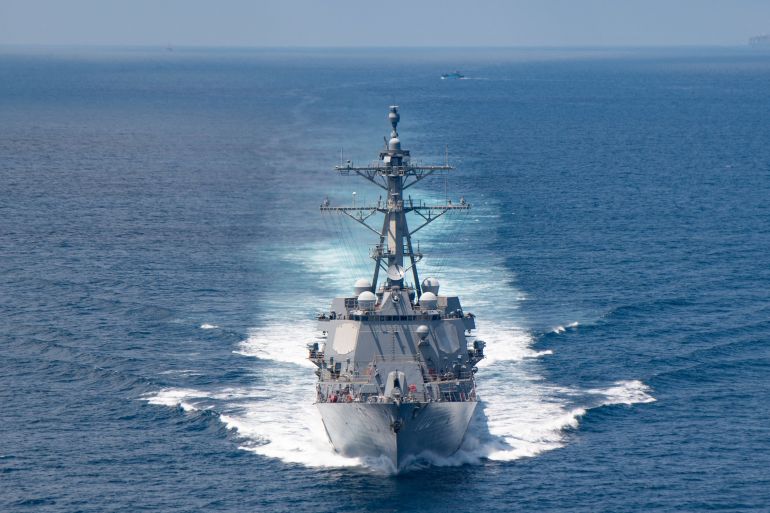US warships transit Taiwan Strait in a first since Pelosi’s visit
Transit operations are the first since China carried out unprecedented military drills in response to US House Speaker Nancy Pelosi’s visit.

Two United States warships have sailed through the Taiwan Strait in the first such operation since China staged unprecedented military drills in the waterway in response to a visit to Taipei by US House Speaker Nancy Pelosi.
In a statement on Sunday, the US Navy said the transit “demonstrates the United States’ commitment to a free and open Indo-Pacific”.
Keep reading
list of 4 itemsTaiwan says Beijing trying to rewrite ‘status quo’ across strait
‘We will not be bullied’: US politician arrives in Taiwan
Taiwan unveils record defence budget amid tensions with China
“These ships transited through a corridor in the strait that is beyond the territorial sea of any coastal state,” it added.
In recent years, US warships, and on occasion those from allied nations such as the United Kingdom and Canada, have routinely sailed through the strait, drawing the ire of China which claims self-ruled Taiwan against the objections of its democratically-elected government.
Pelosi’s Taiwan trip in early August infuriated China which saw it as a US attempt to interfere in its internal affairs. China subsequently launched military drills near the island which have since continued.
Three US officials told the Reuters news agency on the condition of anonymity that US Navy cruisers Chancellorsville and Antietam were carrying out the operation.
Such operations usually take between eight and 12 hours to complete and are closely monitored by the Chinese military.
John Kirby, a spokesperson for the US National Security Council, said the ships’ passage was “very consistent” with the US “one-China” policy and of seeking “a free and open Indo-Pacific”.
The Chinese military’s Eastern Theater Command said it was following the ships and warning them.
“Troops in the theater remain on high alert and are ready to thwart any provocation at any time,” it added in a statement.
Taiwan’s defence ministry said the ships were sailing in a southerly direction and that its forces were observing but that “the situation was as normal”.
The narrow Taiwan Strait has been a frequent source of military tension since the defeated Republic of China government fled to Taiwan in 1949 after losing a civil war with the communists, who established the People’s Republic of China.
A week after Pelosi’s visit, a group of five other US legislators visited Taiwan as well, with China’s military responding by carrying out more exercises nearby.
Senator Marsha Blackburn, a US legislator on the Senate Commerce and Armed Services committees, arrived in Taiwan Thursday on the third visit by an American dignitary this month.
The Biden administration has sought to keep the tension between Washington and Beijing, inflamed by the visits, from boiling over into conflict, reiterating that such congressional trips are routine.
The US has no formal diplomatic relations with Taiwan but is bound by law to provide the island with the means to defend itself.
China has never ruled out using force to bring Taiwan under its control.
Taiwan’s government says the People’s Republic of China has never ruled the island and so has no right to claim it, and that only its 23 million people can decide their future.
Samir Puri, senior fellow at the International Institute for Strategic Studies Asia office, said the US sending warships through the Taiwan Strait within a month of Pelosi’s visit was an “extraordinary projection of power” from Washington.
“The US has of course sent warships through the Taiwan Strait before. But the real significance is that the Pelosi visit happened on August 2 and this is taking place three weeks later,” Puri told Al Jazeera.
“It’s the sequencing — the Speaker of the House going to Taiwan, and the fact that the US felt confident enough within a month to send these two guided-missile cruisers through the Taiwan Strait. It is extraordinary from the US perspective to be able to project this kind of strength and defiance in the face of China’s claim to want to reunify Taiwan at some point in the future.”
Puri said the incident is a “difficult” one for China to react to.
“There’s nothing the Chinese can do in relation to those two cruisers in particular. But what we’ve seen in the recent past is that the Chinese have signalled their displeasure at US activities of all kinds by sending their own aircraft over Taiwan’s Aerial Identification Zone, which is an area that extends around the island of Taiwan,” he said. “So that’s a very high possibility – another overflight of an armada of Chinese planes into Taiwan’s Aerial Identification Zone.”